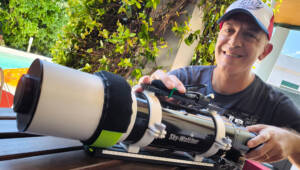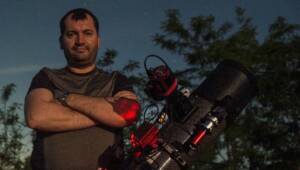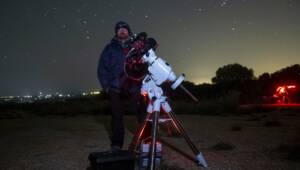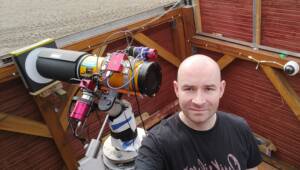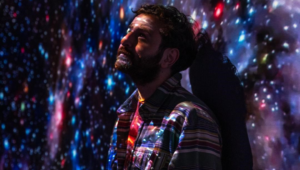Hello Stefan, thanks for accepting our interview invitation. Congratulations on winning the ASIWEEK competition in week #17/2023!
Q1: At first, congratulation that your nice image won #ASIWEEK. Can you introduce yourself to us?
I am very honored that my picture of the Jelly Fish Nebula has been voted the ASIWEEK picture of the week. Thank you very much! My name is Stefan Thrun, I‘m 46 years old, I’m married and live in the city of Jever on the North Sea coast in Germany. I am a professional soldier with the German Air Force.

Q2:What makes you become an astrophotographer and how long have you been?
I have been interested in astronomy and space travel since I was a child. For a long time, I have been visually observing the starry sky with a telescope. In 2018, I attended an astronomy event, which was about the photography of the starry sky. Since then, I started astrophotography.

Q3: What gear do you use? Any photos of them?
I have the EQ6R pro mount and two telescopes for photographing. I use the Takahashi FSQ 85 ED for large objects such as nebula, the TS 130 Tripled APO I usually use in the galaxy season. My first camera was a Canon 1300da. After about 1 year, I switched directly to mono photography with the ZWO ASI 1600MM, followed by the ZWO ASI 294MM. Currently, I use the ZWO ASI 2600MM.


Q4:Where do you normally take astrophotos, from your backyard or somewhere dark but remote?
I take pictures exclusively from our garden. I still have a lot of luck because the sky here in the north of Germany has a Bortle 4.



Q5:Except for astrophotography, do you have any other hobbies? What connections between them?
I love to ride a road bike, both hobbies are very nature-related, which I like very much. If time permits, I still like to do plastic model making in special space models.

Q6:As to your winning image, Jelly Fish Nebula, would you please tell us how did you capture it? Would you like to share with us some detailed camera settings?
I exposed the Jelly Fish Nebula over 9 nights with the Takahashi FSQ 85 ED and the ZWO ASI 2600MM. In total, it has been about 24 hours of integration time. The RGB filters with 20×120″ each was used for the stars. The entire Nebula was exposed with the usual narrowband filters HaOIIISII. Ha 95×300″, OIII 90×300″, SII 75×300″.
The IMX 571 sensor of the ZWO ASI 2600MM was cooled to – 10 degrees. Gain 100 and Offset 50 were used for all filters.


Q7:How long do you normally spend on processing after data acquisition? What do you think is the most difficult part of the processing for you?
I always take a lot of time to work on the PC. This can take on for a few weeks. It often happens that after a few days of processing, I am not satisfied and completely start from a new start.
The challenge is to get an appealing color balance into the picture. This is often not easy in my eyes. I always take a lot of time for the stars, not an easy task.

Q8:Do you often discuss astrophotography with your family or friends? Will they join you on the imaging nights?
Sometimes it happens that I ask my wife during the editing how the picture currently affects her.
My wife occasionally looks over my shoulder in the garden when I start a new project.
During the different planet seasons, the whole family and friends are happy to catch a glimpse through the telescope.

Q9:What do you think astrophotography has brought to your life? Does it change you in any sort?
For me, astrophotography is a fascination with perfection. To experience celestial objects that you can see with the naked eye and often not with a telescope then visibly in colors is indescribable.
To photograph galaxies and nebulae images that you know from the schoolbooks, now real and independently from the garden, is a breathtaking and exciting experience.

Q10: Is there anything you want to tell beginners?
Never give up, even if our hobby is extremely learning-intensive and demanding at the beginning. Through setbacks, you gain valuable experience, and you get better and better.
No one can take away the feeling of happiness with your first and other fantastic pictures.

Q11: How do you think about the future development of astrophotography? Do you think we will have more friends join us?
I think through the introduction of ASIAIR you have succeeded in taking a very good step towards facilitating the handling of Astro software. The constant further development of this product and the current introduction of the AM5 makes it quite easy for beginners to get into the hobby.

Q12: What’s your impression of ZWO? Is there anywhere you think we can do better?
I am extremely satisfied with my products from you. Keep the quality up today. Thank you!



